Baltimore Symphony Orchestra Record Collection Finding Aid
Collection Title: Baltimore Symphony Orchestra Record Collection
Inclusive Dates: 1890-2012
Bulk Dates: 1916-2008
Size: 790 linear feet
Scope and Contents:
This collection includes administrative records, printed material and programs, and audio/visual material. The administrative records include financial records, planning and development records, artistic and educational records, and scrapbooks, as well as managerial records and correspondence. The printed material contains season brochures, Overture magazines, programs, progress reports, and other miscellaneous publications. Audio/visual materials include photographs of the orchestra, orchestra members, events, conductors, and guest artists, and also include recordings in various formats of performances, broadcasts, advertisements, rehearsals, and interviews.
Historical Note:
After a few seasons of performances in the 1890s, the Baltimore Symphony Orchestra officially commenced in 1916, becoming the first municipal symphony orchestra in the country when the Baltimore City Council appropriated $6,000 for six concerts held at the Lyric Theatre. The 53 member orchestra was first managed by city-appointed Frederick Huber, and conducted by Gustav Strube, head of the Department of Harmony and Composition at Peabody Institute. The City of Baltimore continued to support the Orchestra for 26 years, within which time the orchestra introduced distinguished guest conductors, children’s concerts, recognition of local talent, performances for minorities, and radio broadcasts. In 1942, the Baltimore Symphony Orchestra separated from city government and became an incorporated, independent association. The Orchestra, growing the budget and the length of the season, soon introduced tours and run-out concerts to nearby towns which were supported by various symphony societies, festivals celebrating composers, and held their first performance at Carnegie Hall in New York. The Orchestra also began performing with the Baltimore Civic Opera Company. Prestige for the group grew as Sergiu Comissiona took the helm in the late 1960s, residing over televised performances, commercial recordings, international tours to Mexico and Europe and later Asia, and a Young Conductors’ Competition. In 1982, the construction of a symphony hall named after Joseph Meyerhoff, President of the Board of Directors and instrumental to the growth of the institution, was completed, giving the Baltimore Symphony Orchestra a concert home. Through these periods of growth, the relationship between the musicians and the management experienced discord with player’s strikes in 1968, 1972, 1981, and 1988 over wage and benefit disagreements during contract negotiations. Despite these disagreements, the Orchestra continued to gain acclaim, winning their first Grammy Award in 1990 for a recording of cello concertos with soloist Yo-Yo Ma conducted by David Zinman, which was followed by two more Grammys in 1994. The Orchestra continued to develop different programs and series to cater to their patrons, including opening the Strathmore Music Center in 2005, giving the Orchestra year-round venues in two locations, and initiating OrchKids in 2007, continuing the Orchestra’s commitment to classical music education for children. The Baltimore Symphony Orchestra has consistently pushed the gender barrier in leadership positions, appointing Catherine Comet as Associate Conductor in 1983 and Marin Alsop as Music Director in 2007, the first major American orchestra to do so in both cases. Currently, the Baltimore Symphony Orchestra has 94 musicians performing over 170 concerts in a season.
Music Directors:
Gustav Strube 1917-1930
George Siemonn 1930-1935
Ernest Schelling 1935-1937
Werner Janssen 1937-1939
Howard Barlow 1939-1942
Reginald Stewart 1942-1952
Massimo Freccia 1952-1959
Peter Herman Adler 1959-1968
Sergiu Comissiona 1969-1984
David Zinman 1985-1998
Yuri Temirkanov 1999-2006
Marin Alsop 2007-present
Custodial History:
Most of the records for the Baltimore Symphony Orchestra were incrementally deposited at the Peabody Archives between 1990 and 2002. The bulk of the boxes at Peabody were then transferred to the Baltimore City Archives in 2010, with the rest of the collection from the Peabody and remaining boxes at the Joseph Meyerhoff Symphony Hall transferred in 2011 and 2012.
Arrangement:
The collection has been organized into 12 series and corresponding subseries:
Series I. Planning and Operations
1. General Manager Files
2. Assistant General Manager Files
3. Personnel Manager Files
4. Orchestra Manager Files
5. Office Manager Files
6. Music/Artistic Administrator Files
7. Director of Artistic and Educational Programs
8. Concert Department and Manager
9. Manager of Operations
10. Music Director Files
Series III. Board of Directors/Board of Trustees
1. Board of Directors/Board of Trustees Meetings and Agendas
2. Joseph Meyerhoff’s Files
Series VI. Educational Materials
Series VIII. Public Relations and Marketing
1. Marketing Department
2. Office of Public Relations
1. Hall Manager and Operations
2. Meyerhoff Construction
Series X. Programs and Printed Material
1. Programs
2. Printed Material
1. Clipping Books
2. Clippings and Reviews
Series XII. Audio/Visual Material
1. Photographs
2. Audio Recordings
Series XIII. Carroll H. Hendrickson Collection
Series XIV. Baltimore Symphony Associates
This web site is presented for reference purposes under the doctrine of fair use. When this material is used, in whole or in part, proper citation and credit must be attributed to the Maryland State Archives. PLEASE NOTE: The site may contain material from other sources which may be under copyright. Rights assessment, and full originating source citation, is the responsibility of the user.
Tell Us What You Think About the Baltimore City Archives Website!
[ Archives' Home Page ||
Maryland Manual Online ||
Reference & Research
|| Search the Archives ||
Education & Outreach || Archives of Maryland Online ]

